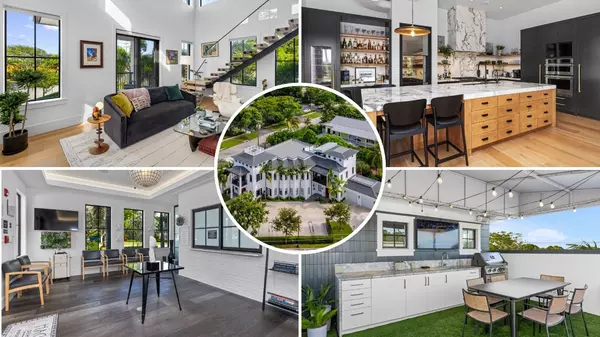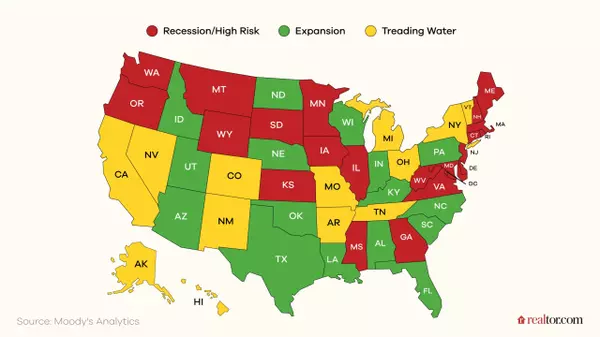Top 10 Safest States To Live In for Your Health, Finances, and Future

Quality of life can mean access to culture and restaurants, good public transportation, and affordable home prices, but none of that means much without feeling safe in your own neighborhood.
Personal finance company WalletHub's latest report ranks the safest states in the country, taking into account not just crime rates, but financial, road, and workplace safety, as well as emergency preparedness, something more crucial these days as extreme weather events become more commonplace, affecting people's personal and financial safety.
Selecting the safest states
To identify the safest states, WalletHub analyzed all 50 states using 52 key indicators of safety, both personal and financial, and grouped them into five categories: personal and residential safety, financial safety, road safety, workplace safety, and emergency preparedness.
Each category contains numerous metrics graded on a 100-point scale, which are then combined to give a total score, with 100 being the highest.
Personal and residential safety weighed not only violent crimes and mass shootings per capita but also metrics such as the number of law enforcement officers, firefighters, and EMTs per capita. After all, when help is needed, how quickly that help arrives is important.
This category was weighted most heavily, with 20 different key factors accounting for 40% of the total score.
Financial safety looked at metrics such as the state's unemployment, fraud, and poverty rates, as well as adults who had savings or a rainy day fund.
Road safety took into account traffic, pedestrian, and bicyclist fatalities, the share of uninsured drivers, and road quality.
Workplace safety analyzed the number of workplace deaths, the median days lost to injuries and illness, and the presence of occupational safety laws.
Emergency preparedness looked at only two factors: the number of climate disasters costing $1 billion or more and the loss amount from climate disasters costing $1 billion or more. Both account for natural disasters from 1980 to 2024.
It's no coincidence that the top four states are all in the Northeast: Vermont, Massachusetts, New Hampshire, and Maine. These states tend to be wealthier, have stricter gun control and higher rates of education, and be less prone to extreme weather events.
"These states pair low crime with strong financial safety," explains WalletHub analyst Chip Lupo to Realtor.com®.
"Several Northeast states have some of the strictest gun control laws in the country. As a result, wealth and economic stability reduces risks, from crime to financial stress, making these states safer overall and more attractive places to live."

How safety affects home prices
Safety does not come cheap. Minnesota is the only one of the top 10 safest states with a median home list price below the national average of $425,000.
"Safety is a major factor in home values because it affects both how secure residents feel and their financial stability," says Lupo.
"Our data makes it clear that states and communities with strong personal, residential, and financial safety profiles tend to support higher home values. In short, safety is a key driver of livability, and livable areas consistently command stronger housing demand."
"Areas perceived as safe tend to attract higher demand, which in turn drives up home prices," adds Hannah Jones, senior economic research analyst at Realtor.com.
"Factors such as ample street lighting, walkability, neighborhood upkeep, and a strong sense of community all contribute to this perception of safety. Each of these elements can independently enhance property values, as households increasingly seek out walkable, community-oriented neighborhoods that provide both comfort and security."
The top states also tend to be wealthier, with the funds to invest in infrastructure maintenance, emergency services, and health systems, says Jones.
"The safe areas then attract and retain higher-income residents, which reinforces the cycle. Wealth and safety are mutually reinforcing," she says.
1. Vermont
Total score: 67.22
Median home price: $509,000
Famous for Ben & Jerry's ice cream, maple syrup, and U.S. Sen. Bernie Sanders, the Green Mountain State undoubtedly has a low crime rate. But it is the state's high rankings in two other categories that vaulted it to the No. 1 spot.
Vermont ranked tops in both financial and road safety. It came in 12th for personal and residential safety, 12th for workplace safety, and 11th for emergency preparedness.
Additionally, nearly 75% of parents believe they live in a safe neighborhood, which is the fourth highest in the country, according to the report. It also came out tops in financial safety, with an unemployment rate of only 2.3%, one of the lowest in the country.
It boasts the lowest share of underwater mortgages in the country and ranks No. 2 for fewest bankruptcies. It also has the second-best road quality in the U.S. and very few motor fatalities.

2. Massachusetts
Total score: 66.56
Median home list price: $759,999
This New England state isn't just one of the most expensive in the country, but also one of the safest, snagging the second spot on the list.
Its personal safety ranks higher than Vermont's—even with the presence of much denser cities like Boston—but the financial safety category is where the state really shines.
Workers have the third-best job security rates in the country, and it has the fourth-best annual growth rate for new jobs. With strict gun control laws, the state saw the eighth-fewest mass shootings between June 2023 and June 2025.
Many people in the state work at its many top-tier health care facilities, giving the state the 24th most EMTs per capita.
3. New Hampshire
Total score: 65.75
Median home list price: $595,000
The Granite State takes the third spot mostly due to its high rankings in two categories: personal and residential safety (No. 2) and financial safety (No. 2). The state has a very low crime rate, with the fewest murders per capita; the second-fewest aggravated assaults; and the second-fewest number of thefts.
Nearly 79% of residents feel they live in a safe neighborhood, the highest percentage in the country. It also has the highest number of neighborhood watch groups per capita.
Most residents are sound financially, with a median credit score of 749, the second-highest in the country.
4. Maine
Total score: 64.69
Median home list price: $475,000
Maine had the second-highest rank in the emergency preparedness category, with extremely low incidents of climate disasters. It also has high marks for personal and residential safety, ranking No. 5.
5. Utah
Total score: 62.88
Median home list price: $595,000
Utah also ranked very high in emergency preparedness, with very low incidents of expensive natural disasters. It also came out high (No. 5) in workplace safety, shining in areas like having few occupational injuries and illnesses.

6. Connecticut
Total score: 62.25
Median home list price: $534,000
Another New England state, Connecticut ranked No. 1 in personal and residential safety, with very low crime rates.
"Beyond neighborhood and school safety, top Connecticut towns also place a strong emphasis on road safety and walkability," Libby McKinney Tritschler of Team AFA/William Raveis, who works in Southport, tells Realtor.com.
She notes town initiatives that added speed bumps to busy roads, expanded bicycle lanes, and made ongoing sidewalk improvements for more and safer walkability.
"These thoughtful upgrades not only protect residents but reflect the community's commitment to maintaining a family-friendly, active, and secure environment," she says.
7. Hawaii
Total score: 61.52
Median home list price: $750,000
Known for its awe-inspiring beauty, Hawaii also ranks high in safety, reaching its highest rank (No. 11) in financial safety, which analyzed factors such as the unemployment and foreclosure rate, poverty rates, and residents' median credit score.
8. Minnesota
Total score: 61.25
Median home list price: $395,000
The state ranks extremely high in road safety (No. 2), which took into account factors like "traffic indiscipline" (such as phone usage while driving and speeding), DUIs per capita, and traffic fatalities.
The Land of 10,000 Lakes also ranked high in financial (No. 5) and workplace (No. 6) safety.
9. Rhode Island
Total score: 60.17
Median home list price: $583,950
This small state's highest ranking categories were in personal and residential safety and emergency preparedness, both ranked No. 8. The state has low crime rates, and residents have very low chances of being negatively affected by a large natural disaster.

10. Wyoming
Total score: 59.04
Median home list price: $492,500
This wide-open state, known for its natural beauty and ranch lifestyle, ranks highest (No. 14) in personal and residential safety, meaning it has low crime, fraud, and drug overdose rates, while simultaneously having robust numbers of law enforcement, firefighters, and EMTs.
Categories
Recent Posts











"My job is to find and attract mastery-based agents to the office, protect the culture, and make sure everyone is happy! "
